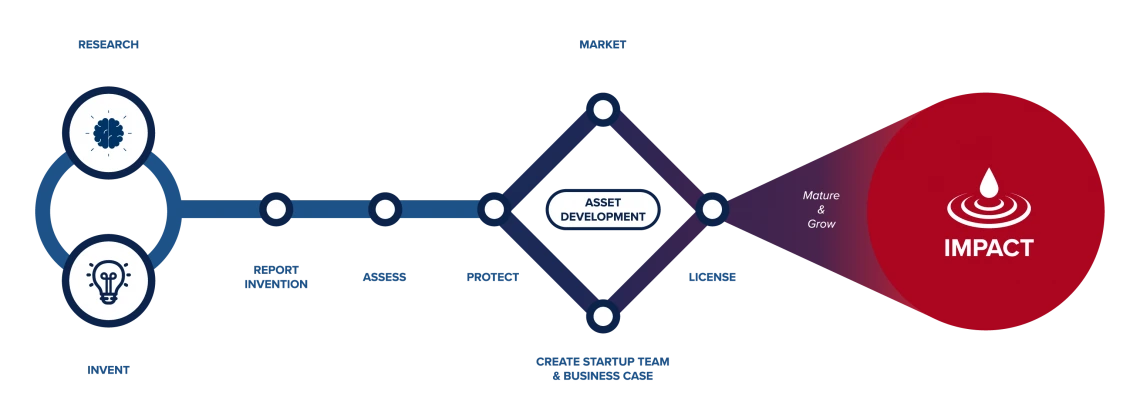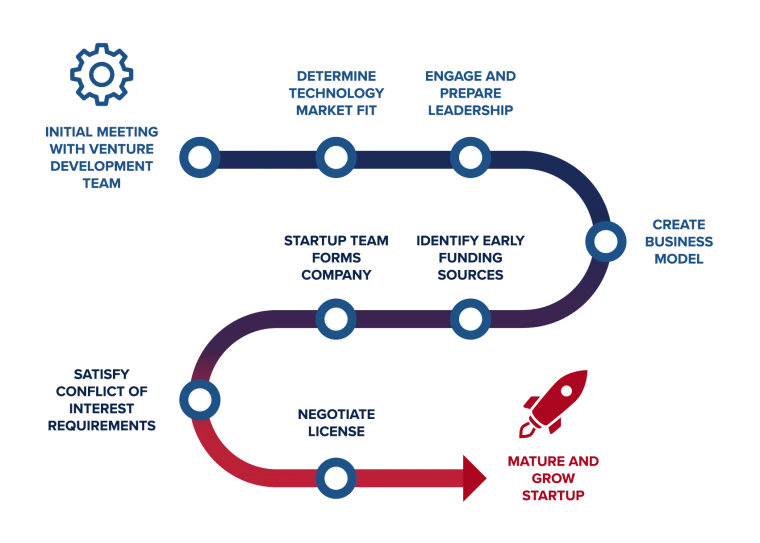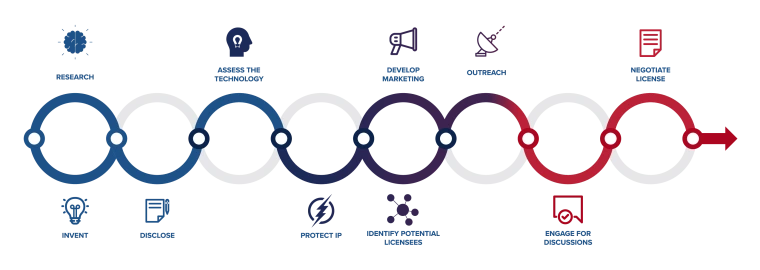The University of Arizona Commercialization Process
Commercialization: the process of moving inventions from their beginnings in university research and innovation out into the marketplace where they can create social and economic impact.

The UArizona commercialization process
Making commercialization work takes a whole team of people who manage a lot of moving parts. We've provided this page to offer full transparency of how TLA works with inventors and ecosystem members to bring UArizona inventions to the marketplace.
Inventions are a natural product of scientific research. Research by UArizona employees, such as faculty, researchers, and graduate assistants, often leads to breakthrough innovations, such as new devices or therapeutics.
Our Licensing Team members have an open-door policy and are always ready to have conversations with inventors from every sector of the university.
It's best to start talking with a TLA licensing manager at the moment you think you may have an invention in mind. An invention is something useful and novel, and is a non-obvious solution to a problem.
While there are no perfect guidelines that describe what constitutes an "invention," our licensing managers work with inventors to determine the right time to file an Invention Disclosure. At that point, we will begin looking at prior art and assessing the market potential for an innovation.
When we receive a new invention disclosure, our team of licensing managers, market researchers and commercialization partners evaluate it to decide the best strategy to move it forward. We look into the market potential as well as the "landscape" of other patents in the field to evaluate how it might address an unmet need in the marketplace.
When the Commercial Assessment shows that an innovation has market potential and is not likely not covered by existing patents, we work with inventors and our national network of patent lawyers to begin the intellectual property protection process.

The Intellectual Property Protection Process
The IP protection process is straightforward at a high level and becomes more complicated as the details proceed. Here are the primary things to understand about each step:
File a Provisional
Also known as a PPA (provisional patent application), this is the first step in filing a patent. The filing of a provisional patent protects the invention for 12 months, after which a decision must be made to convert to a non-provisional, US utility patent or PCT (foreign patent). This filing also “starts the clock” running for when the patent – if issued – expires after 20 years.
Within one year of filing a PPA, there are a number of options to consider if the technology has not been licensed:
- Convert the application to a US utility or PCT
- Abandon the PPA and revert the invention to the public domain
- Release the invention to the inventors
- Re-file the PPA if there is additional material to include that has not yet been publicly disclosed
Convert Provisional to Non-provisional: US Utility or PCT
Twelve months after filing, a decision must be made to convert the PPA to a US utility patent or a PCT.
A US utility patent protects intellectual property only in the U.S.
A PCT, which stands for “Patent Cooperation Treaty” and is the acronym used to refer to patents seeking international protection. If a decision is made to file a PCT, a US National Stage application is due 30 months after the PPA was originally filed.
Office Actions (Non-final and Final Rejections)
An “office action” is a document written by a patent examiner and mailed to an applicant for a patent. The USPTO has a stated goal that the first office action should be completed 15 months after the UA non-provisional is filed.
US Patent Issues
The USPTO’s goal for issuance or rejection is 24 months after the US non-provisional is filed.
US Patent Maintenance Fees
To keep an issued US patent in force, fees must be paid at 3.5, 7.5 and 11.5 years after issuance. All patents expire 20 years from the date of the original PPA filing.
Asset Development funding helps advance inventions that aren’t yet ready to attract licensees or investors. In executing an Asset Development plan, a team of experts, including TLA Commercialization Partners and Mentors-in-Residence, validate an invention's market potential and requirements and ready it for commercialization. These projects often involve activities like creating prototypes, confirming functionality, and exploring scalability. If a UAUArizona technology merits funding, we work with the inventors to shape a full AD proposal, including activities, budgets and timelines.

The Asset Development Process
TLA supports innovation by providing funding to move early-stage inventions closer to market readiness. To be consider for asset development (AD) funding, inventions must be disclosed to TLA. Such funds can be used for prototype development, scalability tests, feasibility studies and more. Here is how the process works.
Application
Applications are accepted year-round. Inventors are encouraged to download the application and start working on it on their own, but TLA licensing managers and mentors-in-residence are available to work collaboratively with inventors to formulate as strong an application as possible.
Inventors who submit a request for help with an asset development application will receive a response within 48 hours of submission.
Evaluation
TLA examines the application and produces a commercialization assessment report (CAR) based on preliminary research into the state of the art and other activities underway in the industry, the IP landscape and the market
The CAR is then shared for feedback at a TLA Round Table meeting, a gathering of technology industry experts who help TLA and UArizona inventors make informed decisions about moving technologies forward for commercialization.
The technology is also reviewed at an internal TLA monthly AD meeting.
All told, the Evaluation process is completed generally within 30 days of application submission.
- IF MORE INFORMATION IS REQUIRED, requests are communicated to the inventing team.
- IF A DECISION IS MADE TO DENY FUNDING, that decision is communicated directly to the inventing team.
- IF FUNDING IS APPROVED, the team is informed and the next phase begins.
Finalize SOW (Statement of Work) and Budget
Approximately two weeks after application approval, dependent upon the engagement of the PI, TLA holds discussions with the inventing team to develop a schedule of tasks and funding tranches. At this time, goals, deliverables, budgets and milestones are finalized.
Execution & Reporting
Throughout the project, progress reports are regularly provided, and additional tranches are released as milestones are met. Upon completion, the team makes a final presentation of their findings. Duration is project- and proposal-dependent.
Some inventions fit well into the products of existing companies or are better suited to an existing company’s strategic plans. We work to identify those synergies and make connections between those companies and UArizona inventors and inventions, with the goal of licensing inventions to companies that are well-situated to take them forward.
Some inventions may be better served as founding technologies for a startup company. With the help of our Commercialization Network – comprised of our Commercialization Partners, our Mentors-in-Residence and over 1,600 domain experts – our Venture Development team collaborates with inventors to bring the right people to the table to build effective startup leadership teams. We dive deep to get a clear picture of the technology landscape so as to create a solid business case and strategy around the invention.

The Startup Creation Process
Initial Meeting with Venture Development Team
TLA works with you to gather information, identify resources and explore commercial pathways to frame the opportunities for your invention.
Determine Technology Market Fit
We then work with you to plan how you will bring your invention to market and take advantage of TLA programs to reduce the risk. We offer guidance, funding and services, such as:
- I-Corps: a short course taught by experts to help teams identify their customers
- Asset Development: funding to prepare early-stage inventions for licensing
- Regulatory Assessment: identifying what types of studies need to be done to gain government approval (if necessary)
Engage and Prepare Leadership
TLA offers educational programs and support resources help you prepare your company for success.
- Workshops offer educational opportunities to learn from experts and exchange ideas
- Mentors-in-Residence are TLA team members with deep experience in technology entrepreneurship
- Advisors from the TLA network volunteer their expertise to advise and guide startup teams
- Ecosystem Resources from UArizona resources like the UA Center for Innovation and the UA Tech Parks to Startup Tucson and connections with investors, we’ll help you get connected for next steps
Create Business Model
Our team works with yours to develop a solid business model that provides detail and clarity for your go-to-market strategy, company structure and funding requirements.
Identify Early Funding Sources
We help you explore potential funding sources such as SBIR/STTR grants, make connections for potential equity funding, and develop an effective, well-constructed pitch.
Startup Team Forms Company
At this point, you register your company and address critical details that that can impact long-term success.
Satisfy Conflict of Interest Requirements
Our team helps you with the UArizona Conflict of Interest (COI), Conflict of Commitment (COC) and Procurement and Contracting Services (PACS) requirements necessary to license IP from the university.
Negotiate License
Your TLA License Manager works with you to negotiate a license agreement for the IP that the startup will commercialize.
Mature and Grow Startup
Our team helps you refine your startup pitch and introduce you to potential funding sources.
The transfer of rights to the IP from the UArizona to either an established business or a startup happens by way of a license: a legal agreement that spells out the details of usage rights and consideration for those rights.

Research & Invent
Research by UArizona employees, such as faculty, researchers, and graduate assistants, often leads to breakthrough innovations, such as new devices or therapeutics. Our Licensing Team members have an open-door policy and are always ready to have conversations with inventors from every sector of the university.
Disclose
This process starts with a conversation between you (the inventor) and your TLA licensing manager where you discuss the nature of the research and the invention you’ve conceptualized.
LEARN MORE ABOUT INVENTION DISCLOSURE
Assess the Technology
The first step before we can license an invention is to assess it for patentability and market potential. To that end, TLA creates a Commercialization Assessment Report (or “CAR”), which is shared via email with the inventors.
The licensing manager discusses the CAR with the inventors, and together, they develop the next steps for the technology.
Sometimes, members of TLA’s network of domain experts are brought in to help inform the discussion.
Protect the IP
If the assessment provides a positive outlook for the technology the decision is made to pursue intellectual property protection, typically in the form of a copyright or patent.
If it is a copyright, the product is immediately protected and no filings are needed.
If patent protection is required, the licensing manager works with the inventor/s and an expert outside law firm to draft and file a patent application.
TLA covers all costs of pursuing a patent.
Develop Marketing
To find potential licensees, TLA prepares non-confidential marketing content for the invention and posts it to the Available Technologies website.
VISIT HTTPS://INVENTIONS.ARIZONA.EDU
We then reach out to our network of domain experts to request referrals and connections in the industry who might be able to help match the technology with potential licensees.
Identify Potential Licensees
Along with our outreach efforts, we also collaborate with inventors to identify indivdiuals in their existing networks who may help make connections. We also work with inventors to make connections at industry and academic conferences they may be attending.
Outreach
We perform a number of functions to market technologies and try to find potential licensees. We use us an online service search for specific industry companies and contacts who we reach out to via email campaigns. We also post inventions to our social media channels.
We have a number of online partners whose specialty is marketing university inventions. These partners focus on connecting university inventions and inventors with specific companies who may be interested in those technologies.
When one of these efforts generates a connection – a lead – a TLA licensing manager follows up personally to initiate a conversation. The LM also brings the inventor into the conversation with the lead at the right time.
Engage for Discussions
At this point, a productive conversation with a potential licensee is getting started! Before talks get into too much detail, TLA works with the lead to put a non-disclosure agreement (NDA) in place to ensure that no confidential information about the invention is revealed.
Once an NDA is executed, both publicly disclosed and confidential information is shared with the company, and the LM holds organizes meetings and conference calls with inventor and company to answer questions and develop the relationship.
When the potential licensee is ready, the LM proposes license terms and shares a draft of the license with company. They also negotiate the terms and finalize the license with the licensee.
If the licensee is a startup – a new company founded to commercialize the invention – the inventors must obtain Conflict of Interest (COI) approval before the license can be signed. In these cases, the LM works with the inventors to guide them through the COI process.
Negotiate License
When all parties have agreed on the terms, the license is executed (signed). From that point on, it is the responsibility of the licensee to report its development of the invention and commercial progress, as well as report and pay royalties back to the university.
In the maturation stage, inventions are nurtured into more fully developed products. At this stage it is up to existing companies to take forward technologies they have licensed. In the case of startups, we remain engaged in helping them move forward. The UArizona Center for Innovation and Tech Parks Arizona provide facilities and resources for maturing university startups, but also offer spaces and services to help non-UArizona companies develop their strategies and connect with university research expertise and resources.
Every invention has its unique commercialization pathway. The invention may have been integrated with other technologies to upgrade an existing product. It may have become the basis of something entirely new. It may make its way to consumer markets, the business-to-business economy or both. A company may have even license it solely for internal use.
All of these scenarios, though very different, share two critical qualities:
- The invention is generating income for its inventors and UArizona, and
- The outcome of a researcher's work has extended beyond academic journals and patents to real-world use, is creating economic impact, and most importantly, contributing to better lives and a better world.

